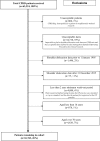Incidence of shoulder dislocations in the UK, 1995-2015: a population-based cohort study
- PMID: 29138197
- PMCID: PMC5695490
- DOI: 10.1136/bmjopen-2017-016112
Incidence of shoulder dislocations in the UK, 1995-2015: a population-based cohort study
Abstract
Objective: This cohort study evaluates the unknown age-specific and gender-specific incidence of primary shoulder dislocations in the UK.
Setting: UK primary care data from the Clinical Practice Research Datalink (CPRD) were used to identify patients aged 16-70 years with a shoulder dislocation during 1995-2015. Coding of primary shoulder dislocations was validated using the CPRD general practitioner questionnaire service.
Participants: A cohort of 16 763 patients with shoulder dislocation aged 16-70 years during 1995-2015 were identified.
Primary outcome measure: Incidence rates per 100 000 person-years and 95% CIs were calculated.
Results: Correct coding of shoulder dislocation within CPRD was 89% (95% CI 83% to 95%), and confirmation that the dislocation was a 'primary' was 76% (95% CI 67% to 85%). Seventy-two percent of shoulder dislocations occurred in men. The overall incidence rate in men was 40.4 per 100 000 person-years (95% CI 40.4 to 40.4), and in women was 15.5 per 100 000 person-years (95% CI 15.5 to 15.5). The highest incidence was observed in men aged 16-20 years (80.5 per 100 000 person-years; 95% CI 80.5 to 80.6). Incidence in women increased with age to a peak of 28.6 per 100 000 person-years among those aged 61-70 years.
Conclusions: This is the first time the incidence of shoulder dislocations has been studied using primary care data from a national database, and the first time the results for the UK have been produced. While most primary dislocations occurred in young men, an unexpected finding was that the incidence increased in women aged over 50 years, but not in men. The reasons for this are unknown. Further work is commissioned by the National Institute for Health Research to examine treatments and predictors for recurrent shoulder dislocation.
Study registration: The design of this study was approved by the Independent Scientific Advisory Committee (15_260) for the Medicines & Healthcare products Regulatory Agency.
Keywords: clinical practice research datalink; cprd; incidence; shoulder dislocation.
© Article author(s) (or their employer(s) unless otherwise stated in the text of the article) 2017. All rights reserved. No commercial use is permitted unless otherwise expressly granted.
Conflict of interest statement
Competing interests: AJ has received a grant from NIHR HS & DR during the conduct of the study, and has received consultancy, lecture fees and honoraria from Servier, UK Renal Registry, Oxford Craniofacial Unit, IDIAP Jordi Gol, Freshfields Bruckhaus Deringer, has held advisory board positions (which involved receipt of fees) from Anthera Pharmaceuticals, Inc., and received research sponsorship from ROCHE. NKA has received honoraria, held advisory board positions (which involved receipt of fees) and received consortium research grants from Merck (honorarium); Roche, Novartis and Bioiberica (grants); Smith & Nephew, Nicox, Flexion Bioventus and Freshfields (personal fees) outside the submitted work. DP-A has received research grants from Amgen and Laboratoires Servier. TH is a GP in London, and is a GP advisor for, but not employed by, the Clinical Practice Research Datalink (CPRD). AR has received personal fees from DePuy Ltd., Aviva Health, AXA PPP Healthcare, AXA PPP International, BUPA, Cigna, SecureHealth, Simplyhealth, Vitality Health (Pru Health) and WPA; a grant from JRI Ltd.; and has a patent for a shoulder replacement prosthesis.
Figures



References
-
- Pope EJ, Ward JP, Rokito AS. Anterior shoulder instability - a history of arthroscopic treatment. Bull NYU Hosp Jt Dis 2011;69:44–9. - PubMed
-
- Goss TP. Anterior glenohumeral instability. Orthopedics 1988;11:87–95. - PubMed
-
- Hill HA, Sachs MD. The grooved defect of the humeral head. Radiology 1940;35:690–700. 10.1148/35.6.690 - DOI
MeSH terms
Grants and funding
LinkOut - more resources
Full Text Sources
Other Literature Sources
Medical
Molecular Biology Databases
